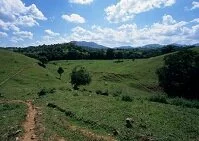Wildlife

Inland landscape
The Dominican Republic has a large number of animals, however there are not many native mammals due to the island's volcanic origin. The only native mammals to the island are a small rodent called the solenodon and the hutia, another rodent. However people have introduced other mammals like dogs, horses, etc. In the seas there are a number of mammals, including whales, dolphins, and manatees. In addition to mammals, there are thousands of fish surrounding the country and these waters contain larger animals like sharks, but also include eels, angelfish, barracudas, grouper, sponges, lobsters, snapper, crabs, and thousands more including coral.
Like the sea life, there are plenty of birds that live on the island or migrate through. These birds are primarily divided into water fowls like egrets, frigate birds, herons, ibis, and flamingos but there are other non-water fowl species that call the islands home such as the parrot, woodpecker, parakeet, owl, and pigeon. The reptilian and amphibian life is also limited in scope, but there are plenty of lizards in addition to smaller numbers of crocodiles, turtles, snakes, iguanas, and frogs among others. There are numerous other species, including insects, most notably butterflies on the island.